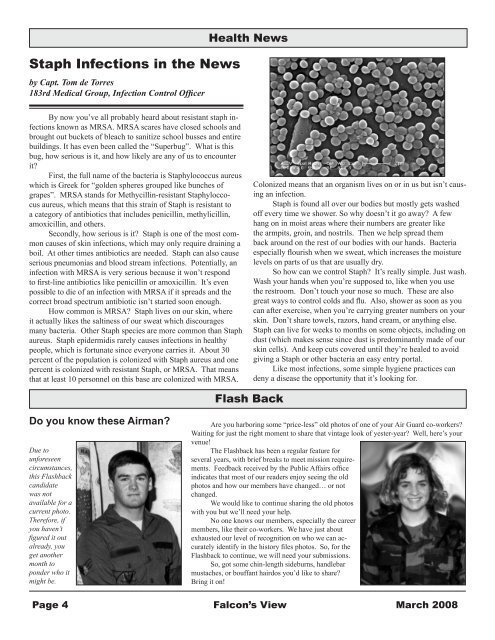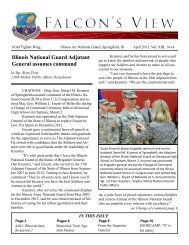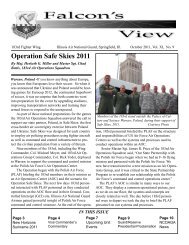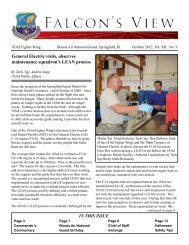Security Forces Squadron under the microscope - 183rd Fighter ...
Security Forces Squadron under the microscope - 183rd Fighter ...
Security Forces Squadron under the microscope - 183rd Fighter ...
Create successful ePaper yourself
Turn your PDF publications into a flip-book with our unique Google optimized e-Paper software.
Staph Infections in <strong>the</strong> News<br />
by Capt. Tom de Torres<br />
<strong>183rd</strong> Medical Group, Infection Control Officer<br />
Health News<br />
By now you’ve all probably heard about resistant staph infections<br />
known as MRSA. MRSA scares have closed schools and<br />
brought out buckets of bleach to sanitize school busses and entire<br />
buildings. It has even been called <strong>the</strong> “Superbug”. What is this<br />
bug, how serious is it, and how likely are any of us to encounter<br />
it?<br />
First, <strong>the</strong> full name of <strong>the</strong> bacteria is Staphylococcus aureus<br />
which is Greek for “golden spheres grouped like bunches of<br />
grapes”. MRSA stands for Methycillin-resistant Staphyloccocus<br />
aureus, which means that this strain of Staph is resistant to<br />
a category of antibiotics that includes penicillin, methylicillin,<br />
amoxicillin, and o<strong>the</strong>rs.<br />
Secondly, how serious is it? Staph is one of <strong>the</strong> most common<br />
causes of skin infections, which may only require draining a<br />
boil. At o<strong>the</strong>r times antibiotics are needed. Staph can also cause<br />
serious pneumonias and blood stream infections. Potentially, an<br />
infection with MRSA is very serious because it won’t respond<br />
to first-line antibiotics like penicillin or amoxicillin. It’s even<br />
possible to die of an infection with MRSA if it spreads and <strong>the</strong><br />
correct broad spectrum antibiotic isn’t started soon enough.<br />
How common is MRSA? Staph lives on our skin, where<br />
it actually likes <strong>the</strong> saltiness of our sweat which discourages<br />
many bacteria. O<strong>the</strong>r Staph species are more common than Staph<br />
aureus. Staph epidermidis rarely causes infections in healthy<br />
people, which is fortunate since everyone carries it. About 30<br />
percent of <strong>the</strong> population is colonized with Staph aureus and one<br />
percent is colonized with resistant Staph, or MRSA. That means<br />
that at least 10 personnel on this base are colonized with MRSA.<br />
Colonized means that an organism lives on or in us but isn’t causing<br />
an infection.<br />
Staph is found all over our bodies but mostly gets washed<br />
off every time we shower. So why doesn’t it go away? A few<br />
hang on in moist areas where <strong>the</strong>ir numbers are greater like<br />
<strong>the</strong> armpits, groin, and nostrils. Then we help spread <strong>the</strong>m<br />
back around on <strong>the</strong> rest of our bodies with our hands. Bacteria<br />
especially flourish when we sweat, which increases <strong>the</strong> moisture<br />
levels on parts of us that are usually dry.<br />
So how can we control Staph? It’s really simple. Just wash.<br />
Wash your hands when you’re supposed to, like when you use<br />
<strong>the</strong> restroom. Don’t touch your nose so much. These are also<br />
great ways to control colds and flu. Also, shower as soon as you<br />
can after exercise, when you’re carrying greater numbers on your<br />
skin. Don’t share towels, razors, hand cream, or anything else.<br />
Staph can live for weeks to months on some objects, including on<br />
dust (which makes sense since dust is predominantly made of our<br />
skin cells). And keep cuts covered until <strong>the</strong>y’re healed to avoid<br />
giving a Staph or o<strong>the</strong>r bacteria an easy entry portal.<br />
Like most infections, some simple hygiene practices can<br />
deny a disease <strong>the</strong> opportunity that it’s looking for.<br />
Flash Back<br />
Do you know <strong>the</strong>se Airman?<br />
Due to<br />
unforeseen<br />
circumstances,<br />
this Flashback<br />
candidate<br />
was not<br />
available for a<br />
current photo.<br />
Therefore, if<br />
you haven’t<br />
figured it out<br />
already, you<br />
get ano<strong>the</strong>r<br />
month to<br />
ponder who it<br />
might be.<br />
Are you harboring some “price-less” old photos of one of your Air Guard co-workers?<br />
Waiting for just <strong>the</strong> right moment to share that vintage look of yester-year? Well, here’s your<br />
venue!<br />
The Flashback has been a regular feature for<br />
several years, with brief breaks to meet mission requirements.<br />
Feedback received by <strong>the</strong> Public Affairs office<br />
indicates that most of our readers enjoy seeing <strong>the</strong> old<br />
photos and how our members have changed… or not<br />
changed.<br />
We would like to continue sharing <strong>the</strong> old photos<br />
with you but we’ll need your help.<br />
No one knows our members, especially <strong>the</strong> career<br />
members, like <strong>the</strong>ir co-workers. We have just about<br />
exhausted our level of recognition on who we can accurately<br />
identify in <strong>the</strong> history files photos. So, for <strong>the</strong><br />
Flashback to continue, we will need your submissions.<br />
So, got some chin-length sideburns, handlebar<br />
mustaches, or bouffant hairdos you’d like to share?<br />
Bring it on!<br />
Page Falcon’s View March 2008













